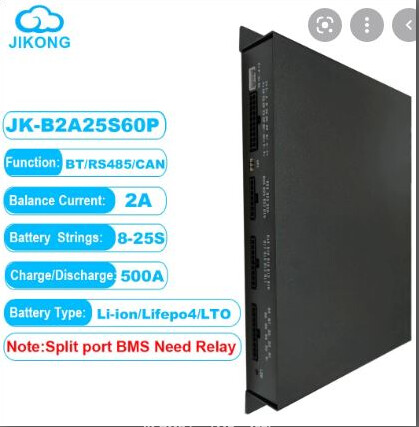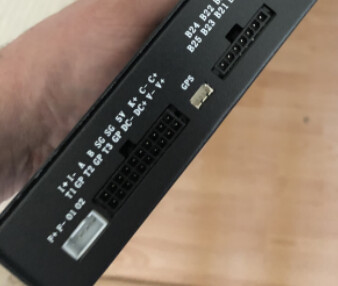The genuine and the clone will likely be nothing alike. With relays/contactors like that the contact material is incredibly important. If you skimp on those, you weld contacts at far lower than rated currents. With a safety critical application like this, I would be very cautious…
There is other overload protection in duplicate.
I say they are clones because these relays are priced above 200Euro apiece.
For that price differential, I am prepared to test it out.
Edit: I would also mention that other BMS’s using this sort of relay, won’t be using 200Euro versions of it.
I am getting info overload (Chinglish would help, but the documentation is straight Chinese) and I need to cut through the bumph:
This is the BMS I ordered, with no special extras, supposedly it has RS485 comms as standard:

The supplier has indicated these are the 485 connections:

Along with the message:
![]()
This is my photo that would seem to correspond:

My question is: Do I need a 485 to USB converter or a TTL to USB converter? Or what do I need and how do I find out? Baud rate?
@Louisvdw, any suggestions?
I know the question was directed to Louis, but yes you would need a USB to Rs485 converter to communicate to for example a Gx device…
If the device that you want to use for communication/control/monitoring has its own Rs485 port, you dont need any converter
The JKBMS is a funny one in that. It needs a RS485 thingmagic that is plugged into the RS485 socket. But it is actually just a TTL->RS485 converter which you then need to use a RS485 → USB converter to plug into your GX device.
You can do that route (that is how I have it at the moment), but for all information I have found and test from some users you can just use a TTL->USB directly which I think is better and cheaper (KISS)
![]()
Edit: There are newer models so it might have changed.
I asked the supplier if it was RS485 to USB or TTL to USB.
The answer I got was: “Yes”.
Edit: I have ordered both now, is there an argument to try a particular one first because it’s less likely to damage something if it’s wrong?
This is not battery-specific, but usually when you see A & B labelled, that’s the differential lines of RS485 (typically at 5V) which need a real RS485 to USB converter, with RX & TX being TTL (5V or lower logic) and finally RXD & TXD being a real COM port at + & - 13V, but these are rarer and rarer now.
But YMMV, especially with Chinese-labelled products. ![]()
Can you find another seller with the same device? They sometimes have better docs.
RS485 and TTL are both 5V based system, so it should be fine to try either.
RS232 is a 12V system, so the best to always try very last.
@mariusm is correct in that in that A/B labels indicate differential lines.
But his statement on Chinese labels is even more correct. It is never as you think. ![]()
Ship’s computer: Captain, the enemy is attacking!
Captain: What!? From the Starboard or Port side!?
Computer: Yes!
Thinking aloud for my own education, so mods please delete if derailing or unhelpful
I think technically RS-485 can be between -7V to + 12V according to the standard?
If not wanting to destroy any adapters and/or attached devices, safest might be to check voltage levels between gnd and A/B on the BMS? Changing designs, bad documentation, and the 12V pin in the photo would make me nervous. Scanning through some of the pdf’s I also saw “TTL/RS-232” indicated somewhere and RS232 I understand to actually have -12V to +12V standard while TTL should be 0V to +3V/5V so it should not really be synonymous?
With that said, various sources (1, 2, 3, 4) suggest that the RS-485 port on the JK BMS is actually at TTL levels (0-3V) and that the JK RS-485/CAN adapters available will be used to convert to the voltage levels and invert logic where required for RS-485 or CAN.
So, unless connecting from the JK BMS to a confirmed RS-485 port, a TTL-USB will likely be sufficient. (until the next undocumented design change… see the comments on baud rate change from 9600 to 115300 in the “source 3” link).
Yes, it is sources like these that led to the confusion.
The supplier now confirming it is a 485 > USB converter and that I don’t need to consider the baud rate.
485 is a 5V system, but the spec allow for a 7V range on top of the 0-5V which give -7V → +12V
So it is a bit confusing in that it allows for up to 12V, but it actually is a 5V system and most controllers will work on that 5V.
See end of the Signals paragraph RS-485 - Wikipedia